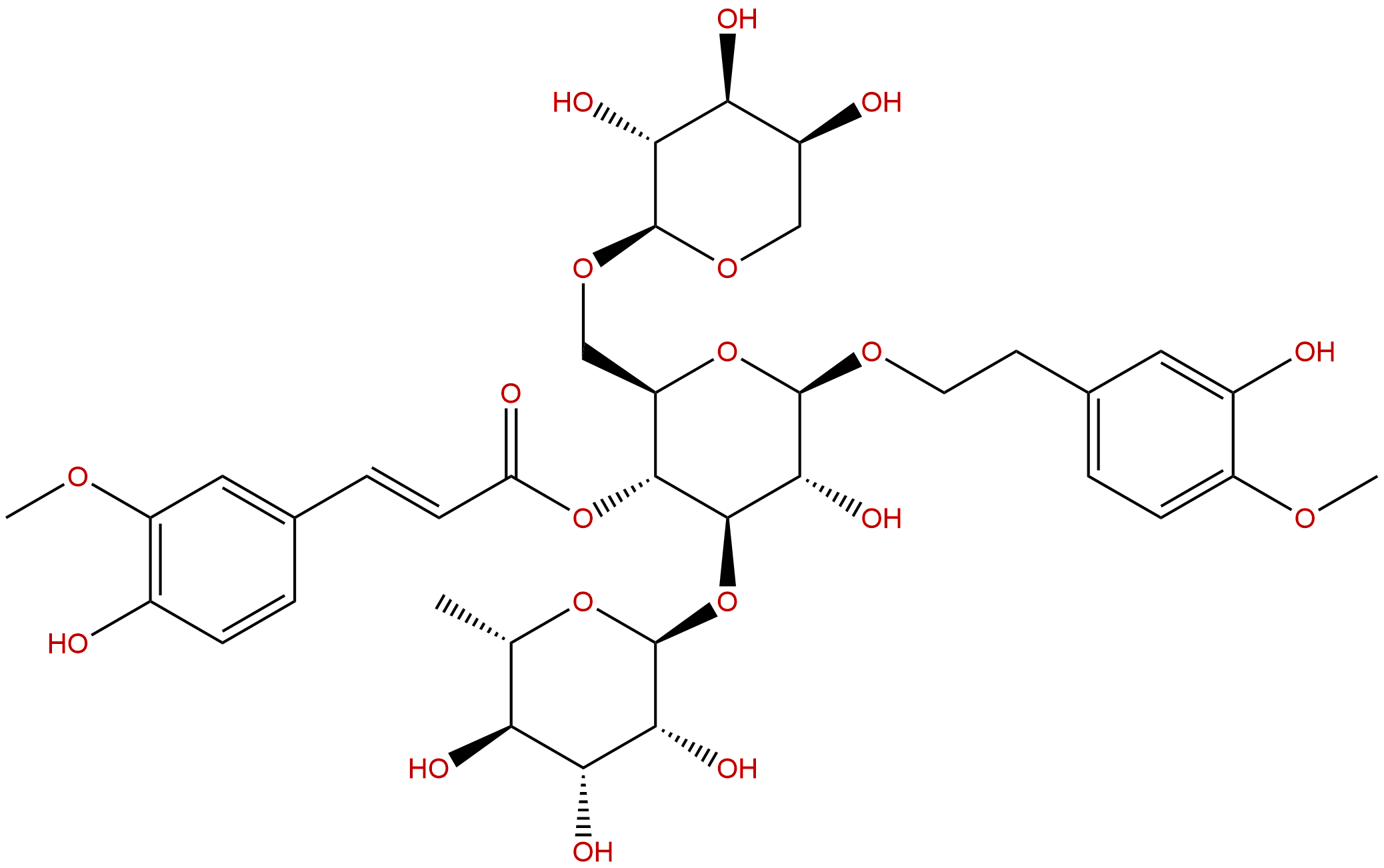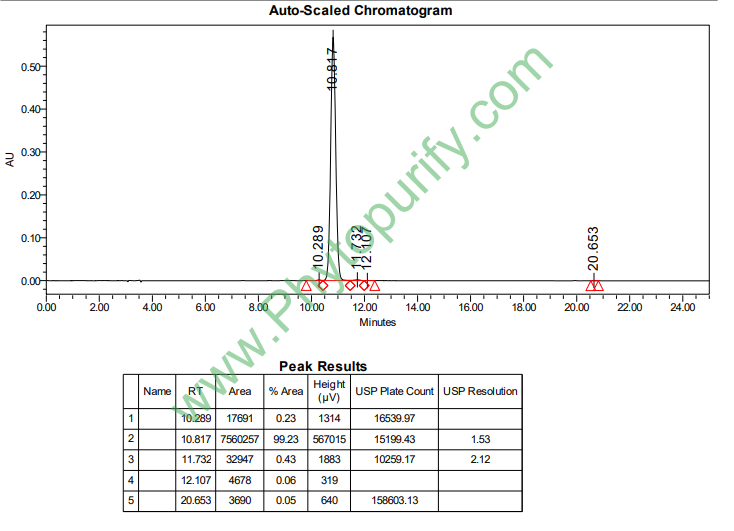
Angoroside CCAS No.:115909-22-3
|
||||||||||
 |
|
|
||||||||

| Catalogue No.: | BP0172 |
| Formula: | C36H48O19 |
| Mol Weight: | 784.761 |
Synonym name:
Catalogue No.: BP0172
Cas No.: 115909-22-3
Formula: C36H48O19
Mol Weight: 784.761
Botanical Source: roots of Scrophularia scopolii and Verbascum spinosum
Purity: 95%~99%
Analysis Method: HPLC-DAD or/and HPLC-ELSD
Identification Method: Mass, NMR
Packing: Brown vial or HDPE plastic bottle
Can be supplied from milligrams to grams.
For Reference Standard and R&D, Not for Human Use Directly.
Inquire for bulk scale.
Description:
Angoroside C has anti-inflammatory effect , it can significantly inhibit LPS-induced PGE(2), NO and TNF-alpha in a concentration-dependent manner; it also exhibits cytotoxic and cytostatic activities against several kinds of cancer cells. Angoroside C has beneficial effects against ventricular remodeling, the mechanism is likely to be related to decreasing the level of Ang Ⅱ, attenuating the mRNA expressions of ET-1 and TGF-β1.
References:
Life Sci. 2004 Apr 2;74(20):2515-26.
Phenylpropanoid glycosides from Scrophularia scorodonia: in vitro anti-inflammatory activity.
Five phenylpropanoid glycosides isolated from Scrophularia scorodonia L. (Scrophulariaceae), namely angoroside A (1), Angoroside C (2), angoroside D (3), acteoside (4) and isoacteoside (5), had been evaluated as potential inhibitors of some macrophage functions involved in the inflammatory process.
METHODS AND RESULTS:
These compounds have been tested in two experimental systems: ionophore-stimulated mouse peritoneal macrophages and human platelets serve as source of COX-1 and 5-LOX, and mouse peritoneal macrophages stimulated with E. coli LPS are the means of testing for COX-2, NO and TNF-alpha activity. None of compounds assayed had a significant effect on LTC(4)-release from calcium ionophore-stimulated mouse peritoneal macrophages. However, the release of PGE(2) by mouse peritoneal macrophages stimulated with calcium ionophore was inhibited by most of these compounds. In the TXB(2)-release assay, acteoside (4), angoroside A (1) and Angoroside C (2) showed a significant effect. These five compounds, except Angoroside C (2) significantly inhibited LPS-induced PGE(2), NO and TNF-alpha in a concentration-dependent manner. In LPS-stimulated macrophages, the phenylpropanoid glycoside Angoroside C (2) only had activity on NO.
CONCLUSIONS:
These results indicate that the pharmacology of these compounds may participate in the anti-inflammatory effect of Scrophularia scorodonia.
Phytomedicine. 2015 Jul 15;22(7-8):705-12.The effect of angoroside C on pressure overload-induced ventricular remodeling in rats.
Our previous study reveals that total rough extract of Radix Scrophulariae has a beneficial effect on ventricular remodeling. HYPOTHESIS: After carrying out a series of preliminary experiments, we speculated that Angoroside C may be the effective agent. STUDY DESIGN: After oral administration, the effect of Angoroside C on ventricular remodeling was evaluated by using a pressure-overloaded rat model, some related indexes were detected in vivo.
METHODS AND RESULTS:
A model of pressure overloaded ventricular remodeling was produced by abdominal aortic constriction (AAC) in rats. The sham-operated rats underwent an identical surgical procedure except for AAC. AAC rats were randomly divided into five groups: model control group, three Angoroside C treated groups (7.5, 15 and 30 mg·kg(-1)) and captopril treated group (40 mg·kg(-1)). The rats were orally administered with the corresponding drugs or drinking water for 4 weeks. The levels of blood pressure (BP), left ventricular weight index (LVWI) and heart weight index (HWI) were detected. Myocardium tissue was stained with hematoxylin and eosin or picric acid/sirius red for cardiomyocyte cross-section area or collagen content measurements respectively. The concentrations of angiotensin Ⅱ (Ang Ⅱ), hydroxyproline (Hyp), matrix metalloproteinase 2 (MMP-2), MMP-9 and tissue inhibitor of metalloproteinase-1 (TIMP-1) in myocardium or serum were determined. Real-time RT-PCR was performed to detect the mRNA expressions of endothelin 1 (ET-1), transforming growth factor β1 (TGF-β1). Angoroside C significantly reduced the BP, LVWI and HWI, decreased the content of Ang Ⅱ, Hyp, diminished cross sectional area of cardiomyocytes and ameliorated collagen deposition. Additionally, it markedly reduced collagen I and III expressions and regulated matrix metalloproteinase-2, 9 and inhibitors of metalloproteinase expressions. Angoroside C also down regulated the gene expressions of ET-1 and TGF-β1mRNA in myocardium.
CONCLUSIONS:
Angoroside C has beneficial effects against ventricular remodeling. The mechanism is likely to be related to decreasing the level of Ang Ⅱ, attenuating the mRNA expressions of ET-1 and TGF-β1.
HPLC of Angoroside C
